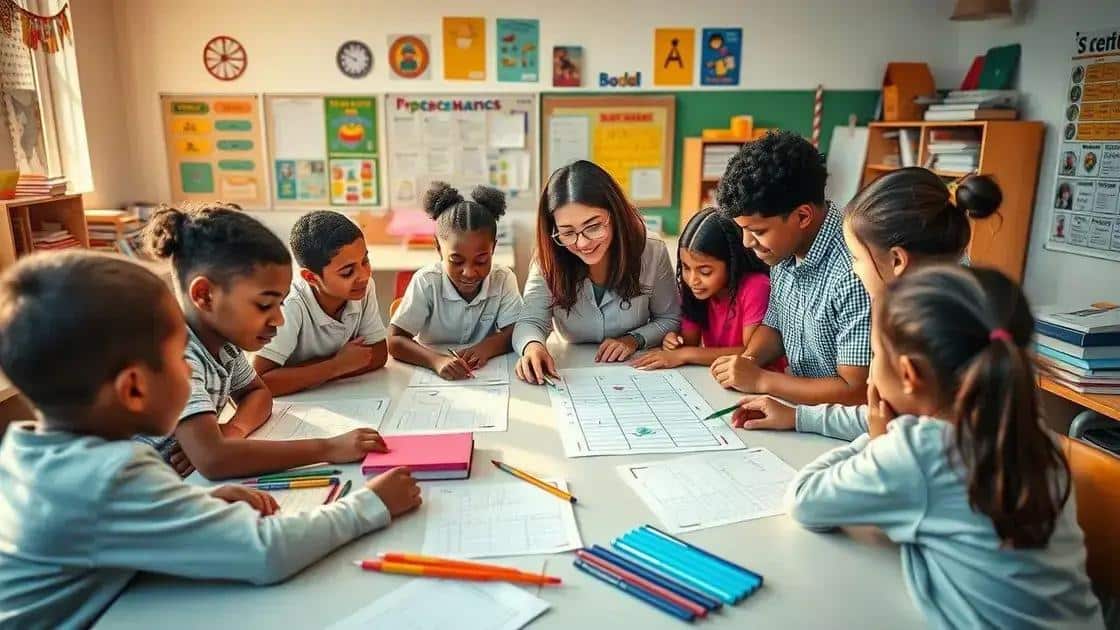Other learning disability support: unlock potential today

Creating inclusive environments for success involves incorporating flexible teaching methods, leveraging technology, and fostering community support to empower students with learning disabilities and promote their academic growth.
Other learning disability support plays a crucial role in helping individuals succeed in various aspects of life. But have you ever wondered what specific strategies and resources can truly make a difference? Let’s dive into the options available to empower those experiencing learning disabilities.
Understanding different learning disabilities
Understanding different learning disabilities is crucial for providing appropriate support. Each type has unique challenges and strengths. By recognizing these differences, we can help individuals navigate educational environments more effectively.
Types of Learning Disabilities
Learning disabilities can vary widely. Some common types include:
- Dyslexia: Difficulty with reading and processing written words.
- Dyscalculia: Challenges in understanding numbers and mathematical concepts.
- Dysgraphia: Issues with writing, including poor handwriting and difficulty organizing thoughts on paper.
- Auditory Processing Disorder: Difficulty understanding sounds, which can affect language development.
Each individual may experience these disabilities differently, which is essential to consider when creating support strategies. For example, students with dyslexia may find it hard to decode words, causing frustration during reading tasks. In contrast, those with dyscalculia might struggle with basic math operations, impacting their performance in class.
A personalized approach is necessary when addressing these learning disabilities. Using a variety of teaching methods can facilitate learning. Creating a supportive classroom environment also helps boost confidence. Teachers should provide clear instructions and practical examples to ensure understanding.
Supporting Learning
To effectively support individuals with learning disabilities, consider these strategies:
- Use assistive technology like reading software and calculators.
- Encourage multi-sensory learning techniques, incorporating visual and auditory elements.
- Provide one-on-one tutoring to help reinforce skills.
- Foster a positive atmosphere where mistakes are seen as part of learning.
By understanding the nuances of different learning disabilities, we can foster an environment where everyone has the opportunity to succeed.
Available support services and resources
Available support services and resources play a vital role in helping individuals with learning disabilities. These services vary widely, offering tailored assistance to meet different needs.
Types of Support Services
Several types of support services are available for individuals with learning disabilities. Here are some key options:
- Special Education Services: Schools often provide individualized education plans (IEPs) designed to support each student’s unique learning needs.
- Occupational Therapy: This service helps improve daily living skills and can address fine motor skills, which are essential for academic tasks.
- Speech Therapy: Many individuals benefit from speech therapy to improve communication skills and language processing.
- Counseling Services: Emotional support through counseling can help students cope with challenges associated with learning disabilities.
In addition to these services, community organizations provide additional resources. For instance, local nonprofits often offer workshops and support groups for families. Online resources like webinars or forums can also be invaluable for gaining insights from others facing similar challenges.
Educational Resources
There are numerous educational resources aimed at helping individuals with learning disabilities succeed. These resources include:
- Assistive Technology: Tools like text-to-speech software and adaptive learning apps can significantly aid learning.
- Helpful Websites: Websites dedicated to learning disabilities offer articles, guides, and tools for both educators and families.
- Books and Manuals: Many authors and experts have written about strategies and interventions that can benefit learners with disabilities.
Utilizing these support services and resources can empower individuals with learning disabilities. They can lead to enhanced educational experiences and better personal development. By understanding the options available, families and educators can create a more supportive learning environment.
Setting achievable goals for improvement

Setting achievable goals for improvement is crucial for individuals with learning disabilities. Establishing clear objectives helps build confidence and fosters a sense of accomplishment.
Identifying Specific Goals
It’s important to identify specific goals that cater to the individual’s strengths and challenges. Start by breaking down broader objectives into smaller, manageable steps. For example, instead of aiming for overall reading improvement, focus on:
- Increasing reading comprehension skills.
- Expanding vocabulary through targeted exercises.
- Improving decoding skills using phonics.
This approach makes it easier to track progress and celebrate small victories along the way.
Implementing SMART Goals
One effective method for goal setting is the SMART framework. SMART stands for:
- Specific: Clearly define the goal.
- Measurable: Make sure you can track progress.
- Achievable: Ensure the goal is realistic.
- Relevant: The goal should matter to the individual.
- Time-bound: Set a deadline for achieving the goal.
For instance, a SMART goal might be: “Improving reading comprehension by reading one book per month and discussing it with a teacher or parent.” This provides a clear path and a timeline for success.
As individuals begin to achieve these smaller goals, it can boost their self-esteem and motivation. Regular check-ins with a teacher or support person help maintain accountability. This ongoing support reinforces the idea that progress is possible.
Adapting Goals as Needed
Flexibility is key when setting goals. If a particular goal proves too difficult, it’s essential to adjust it. This could mean simplifying the goal or providing additional resources for support. The aim is to maintain a positive experience and encourage persistence.
By recognizing and celebrating progress, individuals with learning disabilities can feel empowered to continue pursuing their goals. Setting achievable goals opens up a pathway for lifelong learning and success.
Tech tools that aid learning disabilities
Tech tools that aid learning disabilities are becoming increasingly important in educational settings. These resources can significantly enhance the learning experience for students who face challenges.
Types of Technology Tools
There are several tech tools designed specifically for individuals with learning disabilities. Some useful tools include:
- Text-to-Speech Software: This allows students to hear written text, making it easier for those with reading difficulties.
- Speech-to-Text Software: This aids students in writing by converting spoken words into written text, helping those with dysgraphia.
- Digital Organizers: Apps that help students organize their assignments and manage their time effectively.
- Interactive Learning Platforms: Online resources that provide personalized learning experiences tailored to each student’s needs.
These tools make learning more accessible and engaging. For example, students using text-to-speech software can better comprehend reading materials, which can improve their overall academic performance.
Benefits of Using Tech Tools
Integrating technology into education brings multiple benefits. These benefits include:
- Enhanced engagement in learning activities.
- Ability to tailor learning plans based on individual progress.
- Increased independence for students, allowing them to take charge of their learning.
- Better communication skills through interactive applications.
Additionally, using technology can reduce frustration levels among students, making the learning environment more positive. When individuals can use tools that accommodate their learning styles, they are more likely to succeed. Teachers can also track progress through various software, allowing for timely adjustments in teaching strategies.
Choosing the Right Tools
Selecting the right tech tools is essential. Schools should consider individual needs when evaluating different technologies. Training sessions for both educators and students can ensure effective use. By familiarizing everyone with these tools, schools can maximize their benefits.
Leveraging tech tools in the classroom creates a supportive environment. It empowers students with learning disabilities, enabling them to excel academically and grow their skills.
Creating inclusive environments for success
Creating inclusive environments for success is essential for all learners, especially those with learning disabilities. An inclusive setting ensures that every student feels valued, supported, and empowered to reach their potential.
Understanding Inclusion
Inclusion means integrating students with learning disabilities into general education classrooms. It is important because it promotes diversity and allows students to learn from each other. A supportive atmosphere fosters acceptance and understanding among peers.
Key Strategies for Inclusion
Several strategies can help create an inclusive environment:
- Flexible Teaching Methods: Use a variety of teaching approaches to accommodate different learning styles.
- Collaborative Group Work: Group activities encourage peer learning and allow students to support one another.
- Access to Resources: Ensure all students have access to the necessary tools and materials, including assistive technology.
- Positive Reinforcement: Celebrating achievements, no matter how small, builds confidence and motivation.
By employing these strategies, teachers can create a classroom environment that meets the diverse needs of all students. An inclusive classroom helps break down barriers, allowing every child to participate fully.
Building Community Support
Creating an inclusive environment also requires the support of the entire school community. Involving parents, administrators, and other staff in the process is crucial. Schools should offer training on inclusion and advocate for policies that support diverse learners. When the whole community works together, it strengthens the network of support available to students.
Communication between teachers, parents, and specialists is vital for ensuring that individual needs are met. Regular updates about progress can help everyone stay informed and engaged in the student’s education.
Benefits of Inclusion
Providing an inclusive environment yields numerous benefits for all students:
- Improved social skills and relationships among peers.
- Enhanced academic outcomes due to diverse perspectives and collaboration.
- Greater acceptance and awareness of different abilities.
- Development of empathy and cooperation skills.
Overall, creating inclusive environments for success leads to a more enriching educational experience for everyone involved.
FAQ – Frequently Asked Questions about Creating Inclusive Environments for Students with Learning Disabilities
Why is inclusion important for students with learning disabilities?
Inclusion allows students with learning disabilities to learn alongside their peers, promoting acceptance and understanding while improving their educational experiences.
What are some effective strategies for creating an inclusive classroom?
Using flexible teaching methods, promoting collaborative group work, and ensuring access to resources are key strategies for fostering inclusion.
How can technology support students with learning disabilities?
Technology tools, such as text-to-speech software and digital organizers, can enhance learning experiences and make education more accessible.
What role does community support play in creating inclusive environments?
Community support is vital, as it involves parents, educators, and administrators working together to provide the necessary resources and encouragement for all students.






